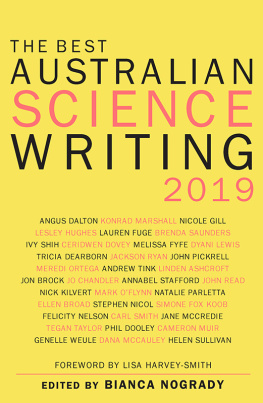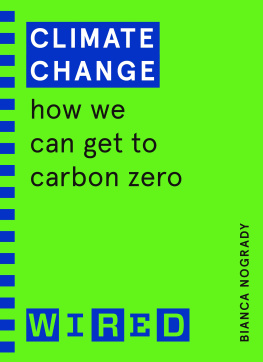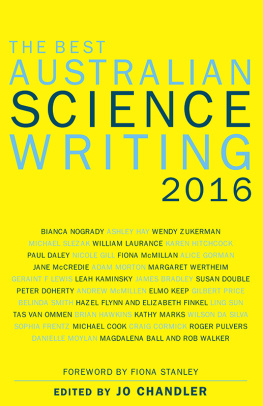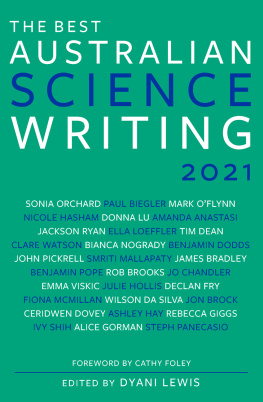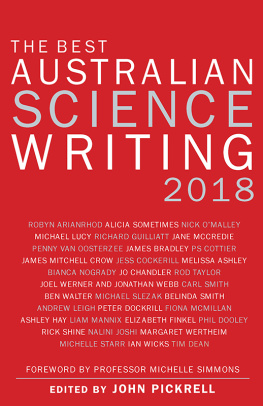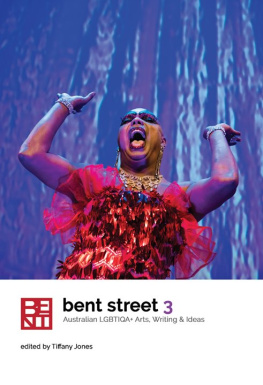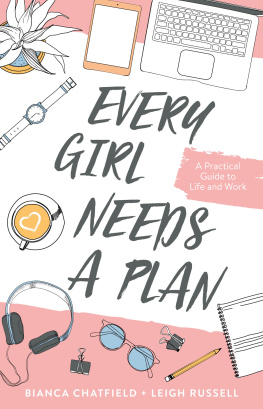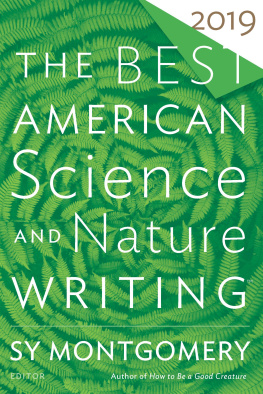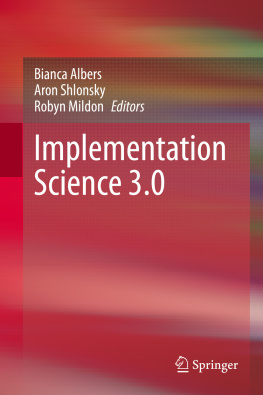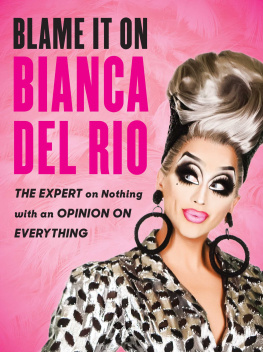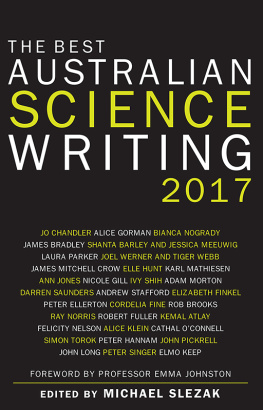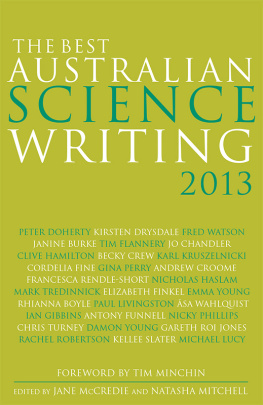Bianca Nogrady - The Best Australian Science Writing 2019
Here you can read online Bianca Nogrady - The Best Australian Science Writing 2019 full text of the book (entire story) in english for free. Download pdf and epub, get meaning, cover and reviews about this ebook. year: 2020, publisher: New South Publishing, genre: Art. Description of the work, (preface) as well as reviews are available. Best literature library LitArk.com created for fans of good reading and offers a wide selection of genres:
Romance novel
Science fiction
Adventure
Detective
Science
History
Home and family
Prose
Art
Politics
Computer
Non-fiction
Religion
Business
Children
Humor
Choose a favorite category and find really read worthwhile books. Enjoy immersion in the world of imagination, feel the emotions of the characters or learn something new for yourself, make an fascinating discovery.
- Book:The Best Australian Science Writing 2019
- Author:
- Publisher:New South Publishing
- Genre:
- Year:2020
- Rating:5 / 5
- Favourites:Add to favourites
- Your mark:
- 100
- 1
- 2
- 3
- 4
- 5
The Best Australian Science Writing 2019: summary, description and annotation
We offer to read an annotation, description, summary or preface (depends on what the author of the book "The Best Australian Science Writing 2019" wrote himself). If you haven't found the necessary information about the book — write in the comments, we will try to find it.
The Best Australian Science Writing 2019 — read online for free the complete book (whole text) full work
Below is the text of the book, divided by pages. System saving the place of the last page read, allows you to conveniently read the book "The Best Australian Science Writing 2019" online for free, without having to search again every time where you left off. Put a bookmark, and you can go to the page where you finished reading at any time.
Font size:
Interval:
Bookmark:

Crafting a ceramic habitat for a handfish
Nicole Gill
Not far from Hobarts Salamanca Market, with its vendors hawking the usual arts and crafts, ceramicist Jane Bamford is creating something extraordinary.
Bamford has just commenced her three-month Art/Science residency at the University of Tasmanias School of Creative Arts. The white walls of her orderly studio at the Hunter Street campus are decorated with maps of the nearby Derwent River, as well as newspaper articles profiling the spotted handfish and its underwater realm.
Bamford, who grew up south of Hobart in Kingston and spent much of her youth exploring Tasmanias east coast, is working with scientists from CSIRO to painstakingly handcraft a key piece of habitat for this threatened species.
The spotted handfish (Brachionichthys hirsutus) was one of the first fish documented in Australian waters, appearing in William Buelow Goulds Sketchbook of Fishes in 1832. Rather than swim, the fist-sized creature walks on modified pectoral fins; its bulky body, forward-jutting dorsal fin and perpetually downturned mouth give it the slightly comical air of a miniature aquatic bouncer. It was relatively abundant in the Derwent River system until the 1980s, when numbers plummeted after the arrival of the Northern Pacific seastar. This invasive species made its way to Tasmania in ballast water from visiting ships.
The seastar doesnt feed on the handfish directly. Rather, it eats the stalked ascidians (sea squirts) that the handfish generally lays its eggs on. While the handfish can lay eggs on other seafloor features, such as seagrasses and sponges, without the ascidians it has struggled to breed successfully. Today, the spotted handfish persists in only a handful of populations in the Derwent River system, and was listed as critically endangered in 1996.
Fortunately, these odd little fish have proven to be quite adaptable: many have taken refuge in bottle reefs formed by beer and rum bottles turfed overboard by sailors for the past hundred or more years. And recent CSIRO studies show that, in the absence of a natural breeding habitat, handfish will lay their eggs on specially designed plastic sticks of a similar size to the sea squirts. Scientists and volunteer divers have planted some 6000 of these in the Derwent over the past couple of years, and the handfish appear to have accepted them as tolerable homes for their eggs.
Bamfords project takes this initial experiment a step further. She is crafting 3000 porcelain spindles known as ceramic artificial spawning habitats for the handfish to use. While the plastic spindles have been adequate so far, CSIRO is keen to find a less-polluting option for the handfish to breed on.
Each artificial spawning habitat consists of two parts: a biscuit-sized disc with a small hole punched in the centre, through which a long, thin spindle about the size of a drinking straw is threaded. Even though it looks like a really simple thing, just a stalk that goes through a disc, says Bamford, in ceramics, youve got movement in the kiln, youve got shrinkage rates. She hands me one from the initial batch. The spindle slots snugly into the ceramic disc. Thats actually quite precise for a ceramic artist. When installed, the disc sits towards the base of the spindle, buried slightly in the sediment to provide stability.
Bamford points at the middle of the stalk. This little area here is where the handfish will lay her egg mass. The female dances around the stalk, and lays her eggs, then the male comes and fertilises them. She will stay with her eggs and protect them. Many fish pass through an intermediate larval stage after spawning, but handfish hatch as tiny perfect replicas of their parents.
Bamford forms her artificial habitats from an exceptionally pure white clay known as Southern Ice Porcelain, developed at the University of Tasmania in the 90s by leading ceramicist Les Blakebrough. Once the artificial habitats emerge fired and glass-hard from the kiln, they seem almost too clean to be installed in the murky depths of the Derwent.
I wanted to work with a white porcelain because I was given this image. Bamford hands me a photo of one of the stalked ascidians. Its got this beautiful stalk, which is quite white. I chose the clay to try to match that. She shows me some fancy artificial habitats shes made, formed with whimsical topknots and decorative indentations. I cant help being a little bit artsy! she admits, laughing. While these more elaborate artificial habitats wont be installed in the wild, they did attract the interest of courting handfish in one of the captive breeding tanks. A female handfish laid her eggs on one of Bamfords creations. Oh, it was just fabulous, she says. It was like, One of my clients is happy!
Ive done a lot of work in the past thats quite interpretive, says Bamford, but this project is amazing because my work is actually going into the environment to support a threatened species. Its a fabulous thing to be involved in.
Bamford walks past the massive slab roller where thick slices of raw clay are thrown down and flattened out like fresh pasta, and past the kilns that will fire the artificial habitats at 1280 degrees Celsius. She ends up at the extruder, a battered metal tube topped with a long lever, mounted on the wall.
This has come out of the Industrial Revolution, says Bamford as she slaps some clay into a lump and shoves it into the extruder. She pulls on the metal lever, ratcheting it to force the clay through a round aperture at its base. The clay streams out like toothpaste perfect 7-millimetre-diameter cylinders that Bamford breaks off and places on a tray for fine-tuning.
Its not enough to just cut the spindles to the correct length clay has a memory, and if not rolled out by human hand, these stalks will bow in the kiln.
If I roll them, it just gives the clay that little bit of compression, so I can have them straight, which is great for the design, and also for packing, delivering and deployment into the Derwent, says Bamford. If youre handling these things underwater, with gloves, in scuba material, you want it to be as easy as possible. Its not just designing something that I want to make its got to actually work in the field. Every one of these pieces is bespoke, handmade.
Its the artists touch, the rolling and rounding of the individual pieces that gives the artificial habitats their final integrity. Her smoothing of burrs from the edges of every unfired disc allows the pieces to slot neatly together to form an elegant whole. One that will, hopefully, catch a passing handfishs eye.

When planetary catastrophe is your day job
Lesley Hughes
The smiling young woman approaches me, hand outstretched to shake mine. I just wanted to say how much I enjoyed your talk, she enthuses. I thank her warmly; Im as grateful for a compliment as the next person. But my heart is sinking. Ive failed, again. The enjoyable talk Ive just delivered was about climate change and its impacts, now and in the future planetary catastrophe in a 40-minute PowerPoint presentation. And now the audience is filing out, eager for a coffee or something stronger, already thinking about where to get a taxi, or what to have for dinner, or any one of a million things other than mounting a revolution to save the planet.
I give a lot of these talks to university students, business groups, community organisations, anyone wholl listen. I work hard to be engaging, keeping the text and complex graphs to a minimum, adding lots of pictures and analogies, personal anecdotes and even the odd joke. And therein lies the conundrum. As a scientist I feel a compulsion to deliver the facts as we currently understand them. But too much gloom and doom is paralysing. Apocalypse fatigue can send people under the metaphorical doona.
Next pageFont size:
Interval:
Bookmark:
Similar books «The Best Australian Science Writing 2019»
Look at similar books to The Best Australian Science Writing 2019. We have selected literature similar in name and meaning in the hope of providing readers with more options to find new, interesting, not yet read works.
Discussion, reviews of the book The Best Australian Science Writing 2019 and just readers' own opinions. Leave your comments, write what you think about the work, its meaning or the main characters. Specify what exactly you liked and what you didn't like, and why you think so.

